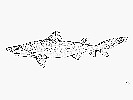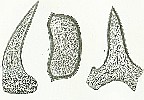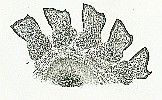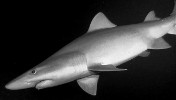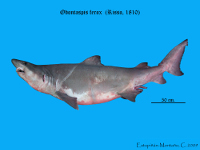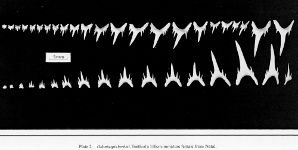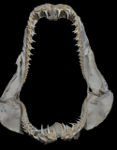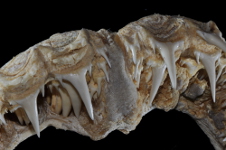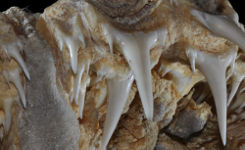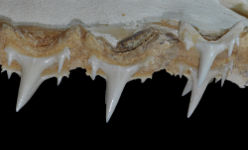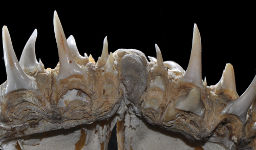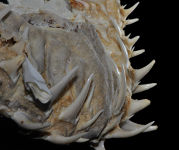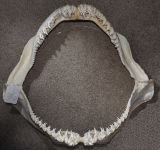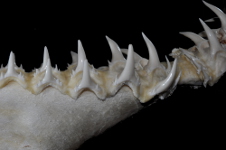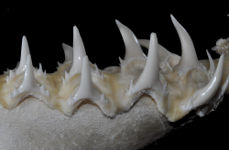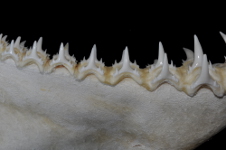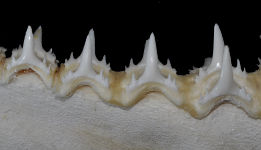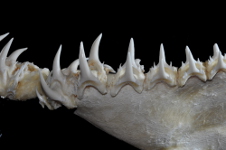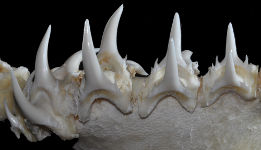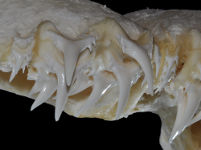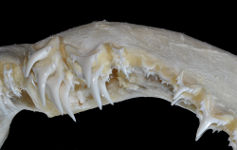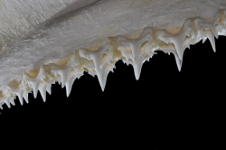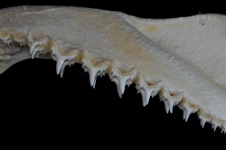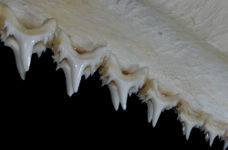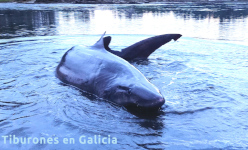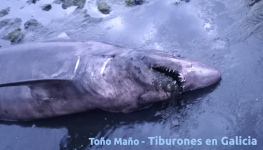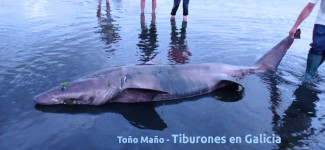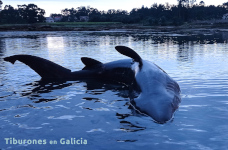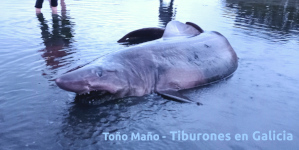Odontaspis ferox
(Risso, 1810)
Smalltooth sand tiger
Classification: Elasmobranchii Lamniformes Odontaspididae
Reference of the original description
Ichthyologie de Nice, ou histoire naturelle des poissons du département des Alpes Maritimes. Paris :F. Schoell, i–xxxvi + 1–388, pls. 1–11.
Ichthyologie de Nice, ou histoire naturelle des poissons du département des Alpes Maritimes. Paris :F. Schoell, i–xxxvi + 1–388, pls. 1–11.
Image of the original description
No image in first description.
No image in first description.
Synonyms / new combinations and misspellings
Carcharias ferox, Odontaspis aff. ferox, Odontaspis cf. ferox, Odontaspis herbsti, Squalus ferox, Triglochis ferox
Carcharias ferox, Odontaspis aff. ferox, Odontaspis cf. ferox, Odontaspis herbsti, Squalus ferox, Triglochis ferox
Types
Odontaspis ferox
XXXX: No types known;
Odontaspis herbsti
Holotype: AMS: IB.2136; Paratype: AMS: IB.1859; AMS: IB.1859.001;
Odontaspis ferox
XXXX: No types known;
Odontaspis herbsti
Holotype: AMS: IB.2136; Paratype: AMS: IB.1859; AMS: IB.1859.001;
Description :
Citation: Odontaspis ferox (Risso, 1810): In: Database of modern sharks, rays and chimaeras, www.shark-references.com, World Wide Web electronic publication, Version 12/2025
Please send your images of "Odontaspis ferox" to info@shark-references.com
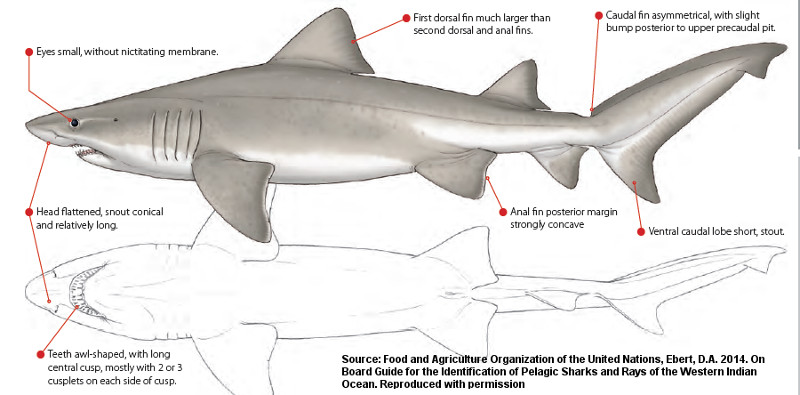
Odontaspis ferox (Risso, 1810), © FAO, Food and Agriculture Organization of the United Nations, Ebert, D.A. 2014. On Board Guide for the Identification of Pelagic Sharks and Rays of the Western Indian Ocean. Reproduced with permission, illustration by Marc Dando , Wildlife Illustrator

Odontaspis ferox (Risso, 1810), © FAO, Food and Agriculture Organization of the United Nations, Ebert, D.A. 2014. On Board Guide for the Identification of Pelagic Sharks and Rays of the Western Indian Ocean. Reproduced with permission, illustration by Marc Dando , Wildlife Illustrator
Common names
 Schildzahnhai,
Schildzahnhai,  Salroig,
Salroig,  Sarda,
Sarda,  Solraig,
Solraig,  Solrayo,
Solrayo,  Surraig,
Surraig,  Tiburón toro,
Tiburón toro,  Odontaspide féroce,
Odontaspide féroce,  Requin,
Requin,  Requin féroce,
Requin féroce,  Squale féroce,
Squale féroce,  Bigeye sandtiger,
Bigeye sandtiger,  Blue nurse shark,
Blue nurse shark,  Bumpytail ragged-tooth,
Bumpytail ragged-tooth,  Bumpytail raggedtooth,
Bumpytail raggedtooth,  Fierce odontaspis,
Fierce odontaspis,  Fierce shark,
Fierce shark,  Herbsts nurse shark,
Herbsts nurse shark,  Ragged-tooth Shark,
Ragged-tooth Shark,  Sand shark,
Sand shark,  Sand tiger shark,
Sand tiger shark,  Smalltooth sand tiger,
Smalltooth sand tiger,  Smalltooth sand tiger shark,
Smalltooth sand tiger shark,  Smalltooth sand-tiger,
Smalltooth sand-tiger,  Cagnaccio,
Cagnaccio,  Cagniacco,
Cagniacco,  Tubarão-areia, Silfjun (malta)
Tubarão-areia, Silfjun (malta)
 Schildzahnhai,
Schildzahnhai,  Salroig,
Salroig,  Sarda,
Sarda,  Solraig,
Solraig,  Solrayo,
Solrayo,  Surraig,
Surraig,  Tiburón toro,
Tiburón toro,  Odontaspide féroce,
Odontaspide féroce,  Requin,
Requin,  Requin féroce,
Requin féroce,  Squale féroce,
Squale féroce,  Bigeye sandtiger,
Bigeye sandtiger,  Blue nurse shark,
Blue nurse shark,  Bumpytail ragged-tooth,
Bumpytail ragged-tooth,  Bumpytail raggedtooth,
Bumpytail raggedtooth,  Fierce odontaspis,
Fierce odontaspis,  Fierce shark,
Fierce shark,  Herbsts nurse shark,
Herbsts nurse shark,  Ragged-tooth Shark,
Ragged-tooth Shark,  Sand shark,
Sand shark,  Sand tiger shark,
Sand tiger shark,  Smalltooth sand tiger,
Smalltooth sand tiger,  Smalltooth sand tiger shark,
Smalltooth sand tiger shark,  Smalltooth sand-tiger,
Smalltooth sand-tiger,  Cagnaccio,
Cagnaccio,  Cagniacco,
Cagniacco,  Tubarão-areia, Silfjun (malta)
Tubarão-areia, Silfjun (malta)
Short Description
Field Marks: A large, bulky shark with a long, bulbously conical snout, eyes moderately large, without nictitating eyelids, mouth long and extending behind eyes, teeth moderately large, with prominent narrow cusps and 2 or more pairs of lateral cusplets, upper anterior teeth separated from lateral teeth by 3 to 5 rows of small intermediate teeth. Anal fin and second dorsal fin smaller than first dorsal but broadbased, first dorsal fin on back and closer to pectoral fins than pelvics, upper precaudal pit present but lateral keels absent from caudal peduncle, caudal fin asymmetrical but with a strong ventral lobe. Colour: medium grey, sometimes with darker reddish spots scattered on body.
Diagnostic Features: Teeth mostly with 2 or 3 pairs of lateral cusplets, root lobes deeply arched and narrow; 3 to 5 rows of small intermediate teeth between upper anterior and lateral tooth rows. First dorsal fin with its posterior margin sloping posteroventrally from its apex; origin of second dorsal fin about over rear ends of pelvic bases; anal fin high and erect, height almost equal to base length; length of dorsal margin of caudal fin about 30% of total length in young. Colour: medium grey above, lighter below, young with black-tipped dorsal fins, some individuals with dark reddish- spots. [518]
Field Marks: A large, bulky shark with a long, bulbously conical snout, eyes moderately large, without nictitating eyelids, mouth long and extending behind eyes, teeth moderately large, with prominent narrow cusps and 2 or more pairs of lateral cusplets, upper anterior teeth separated from lateral teeth by 3 to 5 rows of small intermediate teeth. Anal fin and second dorsal fin smaller than first dorsal but broadbased, first dorsal fin on back and closer to pectoral fins than pelvics, upper precaudal pit present but lateral keels absent from caudal peduncle, caudal fin asymmetrical but with a strong ventral lobe. Colour: medium grey, sometimes with darker reddish spots scattered on body.
Diagnostic Features: Teeth mostly with 2 or 3 pairs of lateral cusplets, root lobes deeply arched and narrow; 3 to 5 rows of small intermediate teeth between upper anterior and lateral tooth rows. First dorsal fin with its posterior margin sloping posteroventrally from its apex; origin of second dorsal fin about over rear ends of pelvic bases; anal fin high and erect, height almost equal to base length; length of dorsal margin of caudal fin about 30% of total length in young. Colour: medium grey above, lighter below, young with black-tipped dorsal fins, some individuals with dark reddish- spots. [518]
Distribution
Eastern Atlantic: Gulf of Gascony, Madeira, Morocco, Mediterranean; also Cape Verde [17657]. Western Atlantic: Yucatan Shelf, Mexico (Ref. 9939), Brazil (Ref. 53443). Indo-West Pacific: off South Africa and Maldives, Madagascar, southern Japan, Australia, and New Zealand [544]. Expected to occur in the Western Central Pacific [544]. Central Pacific: off Hawaii [544]. Eastern Pacific: off southern California, USA and Baja California, Mexico [544].
first record: 2013: Galápagos Islands [19596] [20596]; 2018: Canary Islands [26007]; Source: www.gbif.org
Eastern Atlantic: Gulf of Gascony, Madeira, Morocco, Mediterranean; also Cape Verde [17657]. Western Atlantic: Yucatan Shelf, Mexico (Ref. 9939), Brazil (Ref. 53443). Indo-West Pacific: off South Africa and Maldives, Madagascar, southern Japan, Australia, and New Zealand [544]. Expected to occur in the Western Central Pacific [544]. Central Pacific: off Hawaii [544]. Eastern Pacific: off southern California, USA and Baja California, Mexico [544].
first record: 2013: Galápagos Islands [19596] [20596]; 2018: Canary Islands [26007]; Source: www.gbif.org
Human uses
fisheries: commercial
fisheries: commercial
Biology
Exhibit ovoviparity (aplacental viviparity), with embryos feeding on other ova produced by the mother (oophagy) after the yolk sac is absorbed [733]. Two young born at 105 cm or larger [578]. Distinct pairing with embrace [17086]. Found on or near the bottom of the continental and insular shelves and upper slopes [1388] in 13-420 m (Ref. 58472). Sometimes in shallow water [1388]. Benthopelagic at 13-420 m [17640]. Feeds on small bony fishes, squids, and crustaceans [544]. Uses its long body cavity and large, oily liver to regulate buoyancy.
Exhibit ovoviparity (aplacental viviparity), with embryos feeding on other ova produced by the mother (oophagy) after the yolk sac is absorbed [733]. Two young born at 105 cm or larger [578]. Distinct pairing with embrace [17086]. Found on or near the bottom of the continental and insular shelves and upper slopes [1388] in 13-420 m (Ref. 58472). Sometimes in shallow water [1388]. Benthopelagic at 13-420 m [17640]. Feeds on small bony fishes, squids, and crustaceans [544]. Uses its long body cavity and large, oily liver to regulate buoyancy.
Size / Weight / Age
520 cm TL (female, Walvis Ridge Southeastern Atlantic [27221]); max. published weight: 289.0 kg (Ref. 9939)
520 cm TL (female, Walvis Ridge Southeastern Atlantic [27221]); max. published weight: 289.0 kg (Ref. 9939)
Remarks
shark-references Species-ID=4240;
copyright by: Undersea Hunter Group
shark-references Species-ID=4240;
copyright by: Undersea Hunter Group
Parasites (arranged by Jürgen Pollerspöck)
Cestoda
Copepoda
Cestoda
Copepoda








